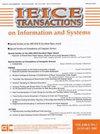基于回归高斯过程潜变量模型的少帧人体运动预测
IF 0.8
4区 计算机科学
Q4 COMPUTER SCIENCE, INFORMATION SYSTEMS
IEICE Transactions on Information and Systems
Pub Date : 2023-10-01
DOI:10.1587/transinf.2023pcp0001
引用次数: 0
摘要
人体运动预测一直是计算机视觉和机器人领域一个有趣的研究课题。它意味着在历史上的三维人体骨骼序列的条件下预测未来的人类运动。现有的预测算法通常依赖于大量带注释或不带注释的动作捕捉数据,并且是非自适应的。本文以流形学习的最新进展为精神,研究了少帧人体运动预测问题。更准确地说,我们的方法是基于这样一种见解,即实现准确的预测依赖于观察空间中少量训练数据在潜在空间中的充分线性表达。为了实现这一目标,我们提出了回归高斯过程潜变量模型(RGPLVM),该模型为模型训练引入了一种新的回归核函数。通过这样做,我们的模型产生了从训练数据空间到潜在空间的线性映射,同时有效地将物理空间中人体运动的预测转换为潜在空间当量中的线性回归分析。与两种学习运动预测方法(最先进的元学习和经典的LSTM-3LR)的比较表明,我们的GPLVM显著提高了小样本量范围内各种动作的预测性能。本文章由计算机程序翻译,如有差异,请以英文原文为准。
Regressive Gaussian Process Latent Variable Model for Few-Frame Human Motion Prediction
Human motion prediction has always been an interesting research topic in computer vision and robotics. It means forecasting human movements in the future conditioning on historical 3-dimensional human skeleton sequences. Existing predicting algorithms usually rely on extensive annotated or non-annotated motion capture data and are non-adaptive. This paper addresses the problem of few-frame human motion prediction, in the spirit of the recent progress on manifold learning. More precisely, our approach is based on the insight that achieving an accurate prediction relies on a sufficiently linear expression in the latent space from a few training data in observation space. To accomplish this, we propose Regressive Gaussian Process Latent Variable Model (RGPLVM) that introduces a novel regressive kernel function for the model training. By doing so, our model produces a linear mapping from the training data space to the latent space, while effectively transforming the prediction of human motion in physical space to the linear regression analysis in the latent space equivalent. The comparison with two learning motion prediction approaches (the state-of-the-art meta learning and the classical LSTM-3LR) demonstrate that our GPLVM significantly improves the prediction performance on various of actions in the small-sample size regime.
求助全文
通过发布文献求助,成功后即可免费获取论文全文。
去求助
来源期刊

IEICE Transactions on Information and Systems
工程技术-计算机:软件工程
CiteScore
1.80
自引率
0.00%
发文量
238
审稿时长
5.0 months
期刊介绍:
Published by The Institute of Electronics, Information and Communication Engineers
Subject Area:
Mathematics
Physics
Biology, Life Sciences and Basic Medicine
General Medicine, Social Medicine, and Nursing Sciences
Clinical Medicine
Engineering in General
Nanosciences and Materials Sciences
Mechanical Engineering
Electrical and Electronic Engineering
Information Sciences
Economics, Business & Management
Psychology, Education.
 求助内容:
求助内容: 应助结果提醒方式:
应助结果提醒方式:


